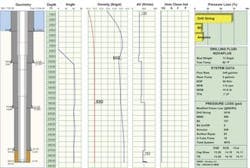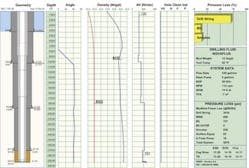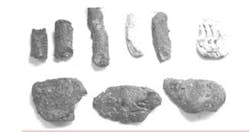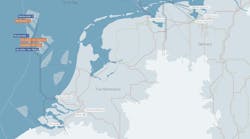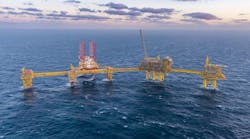Dr. Jim Friedheim
M-I Swaco
A newly engineered synthetic-base drilling fluid that, unlike conventional invert emulsion systems, exhibits a consistently flat rheology even in the deepwater environment, has demon-strated promising performance characteristics in field trials in the deepwater Gulf of Mexico.
As a result of its balanced yield point, which translates into efficient hole cleaning across a broad spectrum of downhole temperatures, the new system has delivered average rates of penetration (ROP) some 30 ft/hr higher than the conventional synthetic-base mud (SBM) drilling fluids used in offset wells. In its initial trial, the system drilled a 17 1/2-in. section at ROPs as high as 150 ft/hr with zero losses. The system also exhibited excellent displacement, low dilution rates, and reduced requirements for chemical treatment, the company reports. In addition, equivalent circulating densities (ECD) values were less than offset wells.
The system represents a new generation in SBM drilling fluid technology by providing rheology properties -- especially yield point, low shear rates, and gel strengths -- that are independent of temperature. This capability provides a clear indication of how the mud system will function over a wide range of temperatures, including seafloor, bottom-hole circulating, and flow-line temperatures. The major technical benefit of the new system is that while surface rheology numbers may at first appear higher than usual, the flat rheology profile allows the fluid to deliver consistent downhole rheology parameters.
Engineered with lower clay content and employing newly developed emulsifiers, rheology modifiers, and viscosifiers, the system was designed to address issues specific with drilling deepwater wells using SBM drilling fluids. In deepwater, the cold temperatures in the riser elevate the viscosities and gel strengths of most standard invert emulsion drilling fluids. Further, operations such as tripping and breaking circulation result in greater surge pressures, which often fracture the formation, leading to whole mud losses. While both performance and environmental characteristics make SBM fluids ideal for the deepwater, whole losses of these premium fluids can be prohibitively expensive.
The newly engineered system appears to overcome this concern by maintaining a lower rheology at cold temperatures when compared to other SBM drilling fluids. There- fore, it essentially eliminates the adverse effects of cold temperature on both viscosity and gel strengths. In addition, solids contamination seems to have little adverse impact on either rheology or gel strengths.
Many conventional SBM fluids address cold-water issues simply by lowering the viscosity. Doing so means the overall rheological profile will decrease in proportion with lowering temperatures. Simply lowering the viscosity does not take into consideration other performance issues common to most drilling operations, such as hole cleaning, barite sag, and cuttings suspension. The newly developed SBM system maintains consistent 150° F mud properties even when confronting lower temperatures.
null
Why flat rheology
The company says that with a flat rheology drilling fluid the mud properties maintain constant values at mud-line temperatures of 40° F; flow-line temperatures that typically are between 55-70° F in deepwater; bottom-hole circulating temperatures, and the standard API 150° F mud check temperature. Conceptually, a system behaving in this fashion can be expected to drill a well at lower equivalent circulating densities (ECD), encounter fewer problems drilling, and successfully avoid lost circulation problems. With a flat rheology system, the on-site drilling fluid engineer is able to design a fluid that can be effective under all down-hole temperatures and pressures conditions. The cold temperature rheology does not become excessive and the high-temperature bottom-hole rheology parameters do not decrease to dangerous levels.
Since the properties do not have to be compromised at one temperature to satisfy requirements of a different temperature elsewhere in the well, the flat rheology profile simplifies the design of the drilling fluid. Often in deepwater drilling operations, the surface rheology must be reduced to decrease the rheology and ECD when encountering cold temperatures. The rheology reduction can result in poor hole cleaning, barite sag, or other down-hole drilling problems related to low rheology at bottom-hole static and circulating temperatures. Conversely, adjusting the rheology upward to compensate for higher bottom hole temperatures can lead to excessive ECD values, excessive gel strengths, and pressure spikes that can break down the formation and lead to lost circulation.
Managing the rheology of conventional synthetic-base systems poses a difficult challenge. With this new generation system, the flat rheology profile eliminates those difficulties and opens the door for more efficient drilling. From a hydraulics-modeling standpoint, the new system allows the user to identify the optimal properties and design a mud system incorporating those properties over a broad range of temperatures.
ECD management
In deepwater, aggressive rates of penetration can lead to accumulation of cuttings in certain parts of the well. During connections, the cuttings will settle around the bottom hole assembly or drill string tool joints, causing pressure spikes once the mud pumps are returned to operation. Consistent fluid properties help to avoid this problem.
Since the rate of cuttings removal managed to keep pace with the rate of cuttings generated, heavy cuttings did not accumulate in the annulus to increase the ECD. In addition, since the constant yield point ensured efficient hole cleaning through- out the wellbore, pack-offs were avoided.
The new system also was successful in eliminating pressure spikes on connections. During the static period, the gel strengths that develop can result in pressure build-up that can break down the formation when the pumps are re-started. Since the flat rheology profile fluid has low clay content, the gels are not excessive. Combining this property with efficient drilling practices, such as rotating the pumps prior to starting the pumps, effectively eliminated the pressure spikes seen previously with conventional synthetic-base fluids.
Most noteworthy is the higher yield points, measured at 150° F, than those observed with conventional synthetic-base drilling fluids. The high yield points at 150° F did not translate into extremely high yield points at mud-line conditions. Accordingly, the high app- arent yield point actually improved the ECD by providing superior hole cleaning performance.
Performance
To analyze drilling performance, the 24-hour average drilling rate of the new system was compared to existing data from wells using conventional synthetic-base fluids. The newly engineered system was introduced to the 13.625-in. casing interval, where offset wells recorded 24-hour average rates of penetration of 53 ft/hr. With the flat rheology fluid, the average increased to 83 ft/hr. The average measured depth for each of these intervals is around 3,600 ft, translating to a time saving in excess of 24 hours of on-bottom drilling time.
In the deepwater environment, a time saving of this magnitude for one interval, readily translates into large savings for the operator over an entire well.
The key factor in achieving a higher average rate of penetration with the new fluid system is the balanced yield point. Therefore, hole-conditioning time can be reduced due to the better cuttings transport ability of the fluid, with no need to halt drilling to circulate the hole clean and lower the ECD. Pre-viously, to obtain optimal hole cleaning properties in the open-hole section, the properties in the riser or cased section of the hole were not necessarily ideal. In addition, the new system exhibited improved displacement characteristics when compared to conventional synthetic systems and delivered ECDs at least 0.1 lb/gal lower.
Field applications
More than 10 deepwater wells have been drilled with the flat rheology SBM. In these field applications, the mud weight varied from 9 lb/gal to 16.5 lb/gal. The geometric profile of the test wells varied from nearly vertical to more than 60° angles, with hole diameters ranging from 22 to 6 1/2- in. Maximum measured depth was close to 27,000 ft, with a bottom hole circulating temperature higher than 200° F. The results of two field trials demonstrate the characters of the flat rheology SBM.
Two intervals were drilled in field trial well A, a vertical 17-in. section and a 14-in. build section. The total footage was about 8,240 ft, and mud weight ranged from 11 lb/gal to 12.6 lb/gal. A bi-center PDC bit was used to drill the first interval, and a drilling-under-reaming bit was used for the second interval. Water depth in the area was more than over 3,000 ft, and the average flow line temperature was about 60-65° F.
The initial mud volume was mixed at the mixing plant using a high-shear hopper. The mud was sheared with a shearing device before loading up to boat.
Drilling began with a relatively low fluid rheology similar to the offset previously drilled with a conventional SBM. The new flat rheology SBM showed no difficulties in displacing the existing water-base mud (WBM), drilling cement, and performing leak-off test.
At the start of drilling, the relatively low rheology delivered a low ECD; however, PWD measurements showed the ECD tended to increase gradually with increasing depths. Hydraulic modeling suggested the fluid rheology was insufficient for proper hole cleaning, especially for the drilling rate and rather large cuttings generated by the bi-center PDC bit.
Most of the cuttings observed were about 2 x 1 x 0.25 in. in dimension or larger. Some showed rounded edges indicating long downhole residence time and mechanical erosion. Although high viscosity sweeps were pumped periodically, the enlarged rat hole below the casing made the sweeping less effective.
To improve hole cleaning, the carrying capacity and low-end rheology of the fluid was increased by treating the system with a small amount of viscosifier and organophilic clays. The yield point was brought up from the low to high 20s, while the 6-rpm reading was raised from low to mid teens. Once the required rheology was established, hole cleaning improved significantly and ECD leveled off without slowing down the pump or drilling rates.
Larger size cuttings that remained intact were observed at the shakers, indicating improved hole cleaning and short residence time. The average penetration rate was kept at 150 ft/hr, and instantaneous penetration rates as high as 300 ft/hr were not unusual.
The well was drilled to section TD without any lost circulation, even though the rheology of the fluid was considerably higher than the offset well employing the conventional SBM.
The second (14-in.) interval was drilled with a similar fluid rheology and no problems reported. The fluid demonstrated the flat profile of low-end rheology, yield point, and gel strengths throughout the operation.
For field trial well B, 17-in., a PDC bit and under-reamer were used to drill the 14-in. and 11 1/2-in. sections rather than bi-center bits. The total footage drilled was about 13,600 ft. Mud weight in this field trial varied from 11 lb/gal up to 13.2 lb/gal. A side track was drilled for geological reason. Maximum inclination of the wellbore reached 60°.
The rheology of the system was again maintained at a relatively high level for effective hole cleaning. Drilling of the 17-in. section was event-free and no drilling-induced lost circulation problems were encountered.
The relatively high rheology was slightly reduced for drilling the 14-in. and 11.5-in. intervals. The well was drilled to TD without experiencing any problems or loss of whole mud to formation.
During the drilling operations, hydraulic modeling was carried out regularly. The actual sizes of cuttings generated were used as input to assess ECD and hole cleaning performance to ensure proper balance of fluid rheology, hole cleaning, and ECD management. Excellent agreement was observed between the predicted ECD values and the actual PWD values.
An extended logging run of 10 days was carried out at TD. The long period of logging at a 60° hole angle with a relatively high mud weight clearly tested the system's capacity for controlling barite sag. Density measurements collected from the flow line and PWD tool all showed minimum variations in mud weight throughout the whole well section, indicating little or no barite sag. In contrast, previous wells drilled with conventional SBM experienced varying degrees of barite sag under similar conditions.
Laboratory comparison of the performance of the barite sag control of the conventional and flat rheology SBM was carried out using field mud samples. The flat rheology SBM showed a tendency to stabilize barite sag more effectively than conventional SBM when tested in a sag flow loop. The ability to control and stabilize barite sag is critical for extended reach operations.
null
Offset well comparison
When compared with offset wells of similar hole sizes but drilled with conventional SBM, the flat rheology SBM in average had higher YP, flatter rheology profile, yet similar or lower ECD. The flat rheology system also delivered faster or comparable penetration rates, less dilution volume, no pack-off's and back-reaming. The better performance of the flat rheology SBM was attributed to its improved carrying capacity and better hole cleaning.
The improved carry capacity also minimized lost circulation problems caused by improper hole cleaning or barite sag. Compared with offset wells, the field trial wells did show less lost circulation problems particularly during drilling operation, indicating the approach used to design the fluid system was a valid approach.
Lost circulation problems encountered during casing and cementing are affected by not only the rheology of the fluid but also the type of tools used and the clearance between casings and open hole. On one section where no surge protection tools were used when running casing, lost circulation did occur. However, when a surge protection tool was used, the lost circulation was prevented on the next interval. Overall, the flat rheology SBM system appreciably minimized the lost circulation problem with an average of 50% reduction during casing run and cementing.
